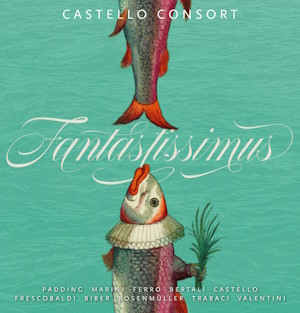
Fantastissimus
Castello Consort
rec. 2022, Doopsgezinde Kerk, Haarlem
Navis Classics NC23013 [76]
This is another of those recordings in which I have to declare an interest, having known most of the people involved for many years as a result of my work at the Royal Conservatoire in The Hague. I was also directly involved with preparing the booklet notes, that take the form of an interview with the Castello Consort and composer Martijn Padding.
The Castello Consort specialises in 17th century music but has always pushed against the boundaries of its repertoire, and this debut recording in many ways is the summit – so far – of their experimentation and search for an ideal sound, and one that gives them the flexibility to go beyond musical resources that they found had been more or less exhausted early on in their existence. A big part of this was their continuo instrument which, after a period of fundraising, now takes the form of a remarkable new organ built on north Italian examples of the period.
A further extension of this pioneering spirit was to invite contemporary composer Martijn Padding to create brand-new music, which has been combined here with some excellent examples of mostly Italian works from the early Baroque. There is a consistency of sonorities and an empathetic use of the period instruments throughout the recording as you would expect, but while ancient and modern complement each other in many ways there is also no mistaking which is which. Padding listened closely to the music of his ancient forebears and found he had to re-adjust his ears considerably in order to inhabit their sound-world, with its different attitude to intonation and harmony. Intonazione I takes us on a brief but extreme excursion into modern ways that would have been entirely alien to 17th century composers, using the organ’s ability to play more than one note per key to create a descent that emphasises the pre well-tempered character of tuning certain notes. Context is all here. Such notes are a vital component of certain keys for the old composers, but here there is no key and there are no ‘wrong’ or ‘right’ notes. The striking harmonies halfway through Marco Antonio Ferro’s Sonate a due that follows this are just one example of where ancient meets modern in this programme.
Padding’s Stylus Phantasticus is deliberately made as a kind of loose-leaf set of inventions, some of which can stand alone, and others deliberately intended to pair with specific pieces, such as the barrel-organ filigrees of Intonazione III in advance of Biber’s virtuoso Sonate for solo violin. The result is a programme whose character is strongest as a whole, and in which every piece is a highlight of one kind or another. I was talking to Daan van Aalst the sound engineer and founder of Navis Classics about this and it turns out this opinion is one shared by more than one listener. In this regard the recording has more of a ‘concept album’ feel than you might expect from looking at the list of works.
Beautifully recorded and superbly performed in a suitable church acoustic, this whole recording is a treasure-chest of discovery. All of the music ‘speaks’ to us with directness and candour. There are uncompromising pieces such as Padding’s Unisono, which has a flavour of his mentor Louis Andriessen in its character, and perhaps even a little sentimentality in the Canzona that follows. The masterful nature of something like Dario Castello’s Sonata Duodecima à 3 in stil moderno show us what those old guys can still teach us today, and the whole thing is the kind of recording that can spark renewed interest in a music period which you might previously perhaps have considered a bit dull.
As usual with Navis Classics this is a very nicely produced product, with a gatefold sleeve, cute photo CD and a substantial booklet with plenty of informative text on every aspect of the programme. The way the Castello Consort plays brims with vitality and colourful expression, looking closely at the character and inventiveness of long-dead composers and blowing away the cobwebs on a whole attic full of their manuscripts.
Dominy Clements
Availability: Navis Classics
Contents
Biagio Marini (1594-1663)
Sinfonia, Sesto Tuono
Martijn Padding (b. 1956)
Stylus Phantasticus
Intonazione I
Choral
Marco Antonio Ferro (1600-1662)
Sonata Undecima à 4
Martijn Padding
Fantasia
Antonio Bertali (1605-1669)
Sonata à 2
Martijn Padding
Echo
Dario Castello (1602-1661)
Sonata Duodecima à 3
Martijn Padding
Inventio
Girolamo Frescobaldi (1583-1643)
Canzon Quinta à 4
Martijn Padding
Intonazione III
Heinrich Ignaz von Biber (1644-1704)
Sonata I: Prelude
Martijn Padding
Hommage to Biber
Presto
Prelude
Johann Rosenmüller (1610-1684)
Sonata Quarta à 3
Giovanni Maria Trabaci (1575-1647)
Constanze Stravaganti
Giovanni Valentini (1582-1649)
Sonata à 6 stromenti
Martijn Padding
Addio
Aeolin Cascades


















